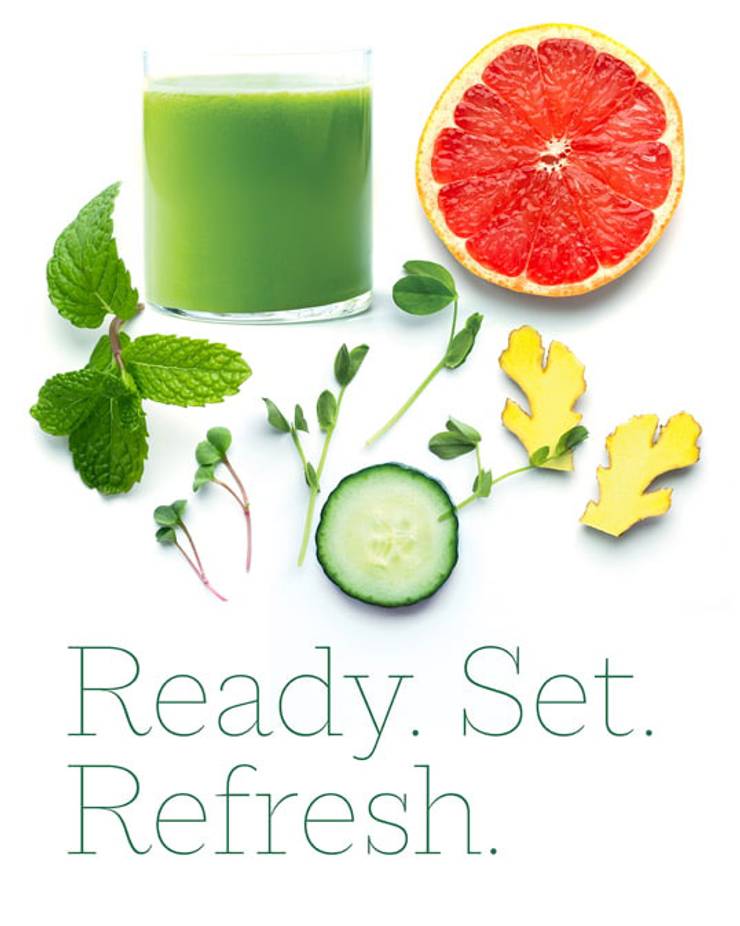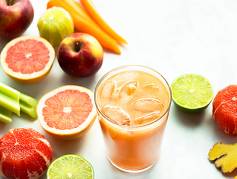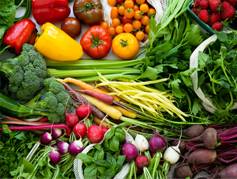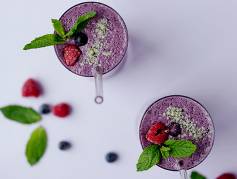Articles
Tips for Juicing
All Year
We’re kicking off 2024 with a 5-Day Juice Challenge. Let’s commit to making one juice a day together to help inspire positive change and motivate our community to consume more nutrients throughout the entire year.
The challenge starts on January 15! For more information on how to participate in the challenge, follow along with us @namawell on Instagram.
Prepare ahead of time and download the 5 recipes we will be juicing all week, plus the shopping list to make it easy.
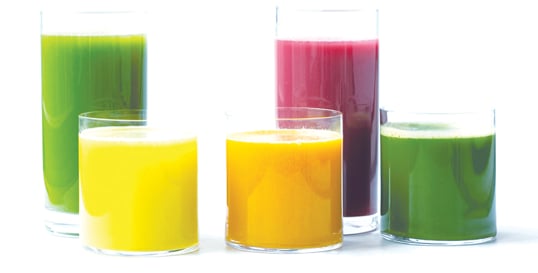
DOWNLOAD RECIPES + SHOPPING LIST
How to Make Good Habits Last
Almost everyone wants their lives to be a little better, happier, and healthier. Right? That’s what New Year resolutions are all about—how to make this year better than the one before.
For many people, making positive changes is the goal but then life gets in the way. You set the best intentions, only to find yourself having a hard time following through. You make a beautiful green juice, but you don’t love the taste. You go for a run in the first few chilly mornings in January, and then a snowstorm hits. A million things can come up that derail you from your health goals. How can you make your healthy habits stick around for longer?
James Clear, author of Atomic Habits, defines a habit as a routine or practice performed regularly. It’s not something you have to think about. Of course, in
the beginning of building a habit you must put some effort in.
“Keeping behavior changes long enough to experience the benefits is incredibly hard,” according to Donald Donald Edmondson, Ph.D., principal investigator of the Resource and Coordinating Center for the NIH Science of Behavior Change (SOBC) program.[1]
It might be simple, but it’s often not as easy as you think. The good news is that creating a new habit is highly personal. A challenging change for one person is not likely to be as hard for another. Maintaining a behavior in the long term will depend on many factors including your schedule, work, home, and more.
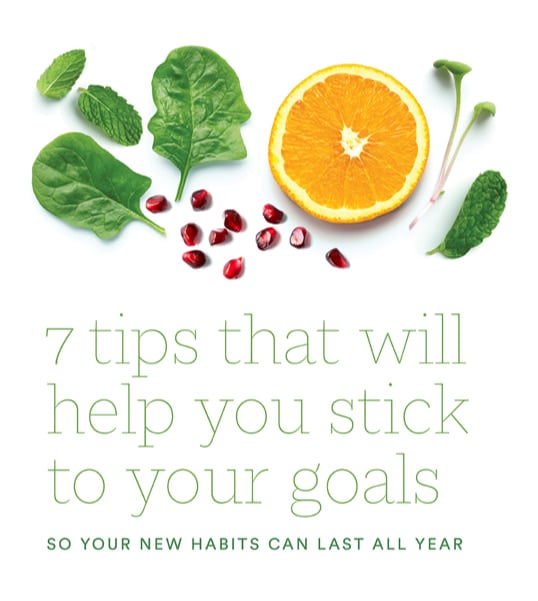
Start Small
One way to approach forming new habits is to bust a myth we have about creating them. In Clear’s blog, he writes, “The myth of radical change and overnight success is pervasive in our culture. Experts say things like, ‘The biggest mistake most people make in life is not setting goals high enough.’ Or they tell us, ‘If you want massive results, then you have to take massive action.’”[2] Those phrases are meant to be
motivational but “any quest for rapid growth contradicts every stabilizing force in our lives,” Clear writes.
It’s for this reason that he recommends finding small triumphs in your day. “The best way to achieve a new level of equilibrium is not with radical change, but through small wins each day,” he writes.
These new habits should need little time and little effort. Examples could be walking for 10 minutes every morning before work, making a juice or smoothie to have as an afternoon snack, or starting your day by drinking 8 ounces of water. It’s so much better to have one juice a day or even once a week than to try to juice more often and fail. Start by adding one extra piece of fruit or vegetable to your day. Then, begin making simple juices with three ingredients or less like apple, ginger, carrot or cucumber and lime. Once you have built the habit, you can improve and add from there.

Avoid Sunday Night Shopping
When it comes to preparing healthy food, shopping is part of the equation. For a more stress-free and productive shopping trip, consider the day and time you shop.
Shopping during busier times can make the process more hectic and may result in having to go back for a second trip or a different store if items are not available. Try getting up early on a Saturday or Sunday morning to beat the crowds. Or make an online order during your lunch break in the middle of the week and have your groceries delivered when you get home later that night.
If Sunday night is your only available time, then make a list and be flexible. If the store is out of broccoli, try kale or Bok choy instead. Can’t find juicing carrots? Baby carrots will work too.
Remember Your Why
Consistent action becomes easier when you are clear why you are doing it. Spend some time in the New Year getting connected to why you want to make change. Write it down in a notebook or put sticky notes around the house to remind you. It helps to be specific and check in on your why from time to time.
Don’t forget to include the incredible benefits of consuming more plant-based foods. [3] The high fiber and nutrients, phytochemicals, antioxidants, vitamins, and minerals in vegetables and fruits have been proven to prevent and reverse heart
disease, improve cholesterol, lower blood pressure, reduce risk of stroke, prevent some types of cancer, and have a positive effect on blood sugar.
Plus, fruits and vegetables help keep you hydrated and offer you more natural energy, which is so helpful when days are shorter in the winter.

Extend The Life of Your Produce
There's nothing worse than shopping for fresh food, and then watching it spoil in your fridge. You can maintain healthy habits by learning to preserve your produce longer. It also helps to make a meal plan for the week and shop for the ingredients you know you will use.
Once you bring the groceries home, don't wash them until you're ready to use them. Or if you want to chop carrots and celery for snacking, store them in containers with water to help them stay fresh longer.
You can also make juices or smoothies ahead of time or when you want to use up produce. Make sure you have containers to store them in. Juices can last for up to 3 days in the fridge in airtight containers or in the freezer for much longer. Smoothies can be kept in the freezer for up to three months.
Eat More Mindfully
Whether you are enjoying a juice, smoothie, or bigger meal, do your best to limit distractions, such as watching TV, answering email, or even talking on the phone while you eat. This mindfulness helps you savor your food.
Take time to engage with your senses—see, taste, smell, touch, and even listen to your food. Digestion begins in your brain. When you feel hungry, the body sends a message to the brain that it's time to eat. By looking at and thinking about the food, you have already begun to enjoy it.
The benefits of eating mindfully are many but one of the best parts is that when you are present with your food, you will feel more satiated. It will also help you tune into your natural hunger cues.

Spice Up Your Food
Feeling bored with the same flavors? Spice it up! In the winter, adding fresh herbs such as cilantro, parsley, or mint can help your food taste more fresh and flavorful.
Not only do herbs and spices taste great, but they add more nutrients too. Plus, spices can help make both juices and smoothies taste more interesting. Cayenne pepper, paprika, or chili powder can bring the heat. Turmeric and ginger add more anti-inflammatory properties.
Drop the Guilt
If you have a day where you end up eating some ultra-processed junk food or don’t eat your recommended servings of fruit and veg, just move on. Don’t let guilt drive your future decisions. Instead, use your energy to make plans for the next day and get excited about how you can add more healthy choices into your day. Each new day brings a new opportunity to build sustainable habits.

Here’s our guide to some of the best seasonal fruits and vegetables this season. Remember: seasonal foods will vary depending on where you live, soil conditions, and weather.

GRAPEFRUIT
This tart fruit is a wonderful addition to any winter plate or glass. A medium grapefruit contains nearly half a day's recommended supply of vitamin C, according to the U.S. Department of Agriculture.[4] Pink and red grapefruit also contain beta carotene and lycopene.
• Shopping Tip: Don’t automatically pick the perfect circle. Look for imperfections, as flattened sides or a more oval shape tend to indicate that the fruit has ripened and is softer and sweeter.
• Storage: For the best flavor, store grapefruits on your counter for up to a week. After that, you can keep them for several weeks in the fridge.
• Health Tip: Grapefruit does have a reputation of interfering with some medications, so talk to your health care provider to clarify what’s safe for you.

NAVEL ORANGE
One of winter’s great pleasures is this bright, sweet, juicy fruit. Navel oranges enjoy their peak season in January and February. They are a delicious addition to any juice, smoothie, salad, dessert, and more. Nutritionally, these oranges are full of vitamin C, magnesium, and potassium.[5]
• Variety Tip: Navel oranges look like Valencia, which are the summer version of sweet oranges with a thinner skin and higher juice content.
• Storage: Keep them on the counter for a few days or fresh for three to four weeks in the fridge.

BROCCOLI
At some point, someone has probably told you to eat your broccoli and with good reason. It’s full of essential nutrients including vitamin C and K, calcium, and potassium.[6] It can be eaten raw or cooked and goes great in juices.
• Shopping Tip: Look for a head of broccoli with tightly closed buds and stalks that look green without any brown spots or yellowing. The stem end should look recently cut.
• Storage Tip: This veggie prefers the crisp coldness of your fridge’s produce drawer. Keep it loosely wrapped in an unsealed bag or wrap the entire head in paper towels to help get rid of excess moisture.

CABBAGE
Part of the Brassica family, cabbage is a hearty green packed with nutrients. Research shows that eating more cruciferous veggies, like cabbage, can reduce certain blood markers of inflammation.[7] Adding cabbage to a juice is a great way to use it up, especially if you have half a head in your fridge.
• Varieties: red, purple, white, and green
• Shopping Tip: Look for a cabbage head that’s bright and free of any brown spots and wilted leaves.
• Storage: Stored in the fridge for about a week or so. You can freeze fresh cabbage, just be sure to cut it into manageable pieces to make it easier to handle as it thaws.,

GINGER
This root comes from a tropical flowering plant that originates in Southeast Asia but now grows throughout the world. Ginger is a close relative of turmeric and both spices have anti-inflammatory properties. Among its many benefits is gingerol, a natural component of ginger root, that benefits the digestive process, according to John Hopkins Medicine.[8]
• Shopping Tip: Look for ginger that has thin skin. Don’t be afraid to smell it first, as it should be aromatic.
• Storage: You can store it on the counter or in a resealable bag in the fridge for about a week. You can also store fresh ginger in your freezer and grate it whenever you need it.
sources:
- https://www.nia.nih.gov/news/adopting-healthy-habits-what-do-we-know-about-science-behavior-change
- https://jamesclear.com/behavior-change-paradox
- https://www.hsph.harvard.edu/nutritionsource/what-should-you-eat/vegetables-and-fruits
- https://fdc.nal.usda.gov/fdc-app.html#/food-details/173033/nutrients
- https://fdc.nal.usda.gov/fdc-app.html#/food-details/746771/nutrients
- https://fdc.nal.usda.gov/fdc-app.html#/food-details/2345151/nutrients
- https://www.ncbi.nlm.nih.gov/pmc/articles/PMC4195422
- https://www.hopkinsmedicine.org/health/wellness-and-prevention/ginger-benefits
- Choosing a selection results in a full page refresh.
- Press the space key then arrow keys to make a selection.
